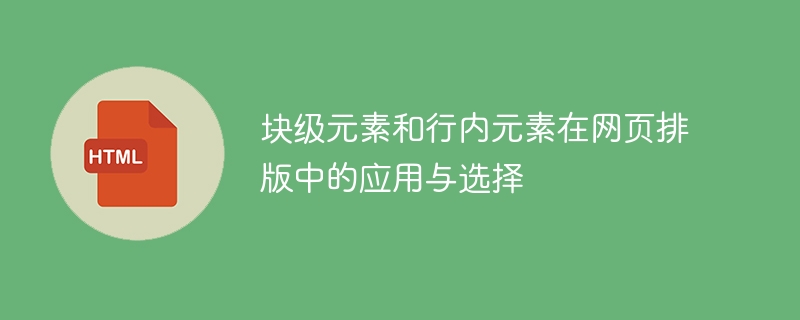Home >Web Front-end >HTML Tutorial >Application and selection of block-level elements and inline elements in web page layout
Application and selection of block-level elements and inline elements in web page layout
- WBOYWBOYWBOYWBOYWBOYWBOYWBOYWBOYWBOYWBOYWBOYWBOYWBOriginal
- 2024-01-07 10:17:111174browse

The application and selection of block-level elements and inline elements in web page layout
In web design and development, we often encounter the need to control the layout and layout of elements. layout situation. Block-level elements and inline elements are two commonly used element types and play an important role in web page layout. This article will introduce the concepts of block-level elements and inline elements, as well as their application and selection in web page layout. At the same time, specific code examples will be provided to help readers better understand and apply.
1. The concepts of block-level elements and inline elements
Block-level elements and inline elements are the most basic element types in web pages. They have different display characteristics and default layout behavior.
- Block Elements
Block-level elements are displayed in the form of blocks on the web page and occupy their own row. Common block-level elements include
,
-, etc.
The characteristics of block-level elements are as follows:
- Occupy one line: Each block-level element will start on a new line until the end.
- Auto-wrap: Block-level elements will wrap automatically, even if the width of the element is not set.
- Have width and height attributes: Block-level elements can control the size of the space they occupy by setting width and height.
- You can set margin and padding: By setting the margin and padding properties, you can add margins and padding to block-level elements.
The following is an example showing how to use block-level elements to implement a simple web page layout:
<div class="container"> <div class="header">Header</div> <div class="content">Content</div> <div class="footer">Footer</div> </div>
- Inline Elements
Inline elements are displayed in rows on the web page and will not occupy a single line. Common inline elements include , , , , etc.
The characteristics of inline elements are as follows:
- Can be displayed on the same line as other inline elements.
- will not occupy a separate line and will not wrap automatically.
- By default, the width and height of inline elements are stretched by the content.
- The width and height attributes cannot be set.
- Cannot set the upper and lower margins (margin).
The following is an example that shows how to use inline elements to achieve the effect of a navigation bar:
<nav> <a href="#">首页</a> <a href="#">产品</a> <a href="#">服务</a> <a href="#">关于我们</a> </nav>
2. Application and selection of block-level elements and inline elements
- Application and selection of block-level elements
Due to the characteristics of block-level elements, they are suitable for the following scenarios:
- Page layout and structure: Block-level elements can be used to build the layout and structure of web pages. By setting properties such as width and height, margins, and padding, you can precisely control the position and size of elements on the page.
- Block division and organization: By placing relevant content in block-level elements, you can easily divide the page content into different blocks, and achieve different appearance effects by setting styles.
- Articles and paragraphs: Block-level elements such as
and
-
are often used to format articles and paragraph content. Good layout can be achieved by setting attributes such as font style and line spacing. Reading experience.
- Application and Selection of Inline Elements
Due to the characteristics of inline elements, they are suitable for use in the following scenarios:
- Inline Content formatting: Inline elements can be used to format text content, such as and can be used to bold and italicize.
- Hyperlinks and navigation bars: Inline elements such as can be used to create hyperlinks, build navigation bars, etc.
- Text that occupies one line: By using the display attribute, you can set certain inline elements as block-level elements so that they occupy one line. For example, it can be used to achieve vertical centering.
In actual use, according to specific needs and layout requirements, we can choose to use block-level elements or inline elements, or combine them. When setting styles, you can change the type of elements through CSS selectors or setting the display attribute.
To sum up, both block-level elements and inline elements play an important role in web page layout. By rationally selecting and applying these two element types, we can achieve rich and diverse web page layout and typography effects. We hope that the code examples provided in this article can help readers better understand and use block-level elements and inline elements.
The above is the detailed content of Application and selection of block-level elements and inline elements in web page layout. For more information, please follow other related articles on the PHP Chinese website!

